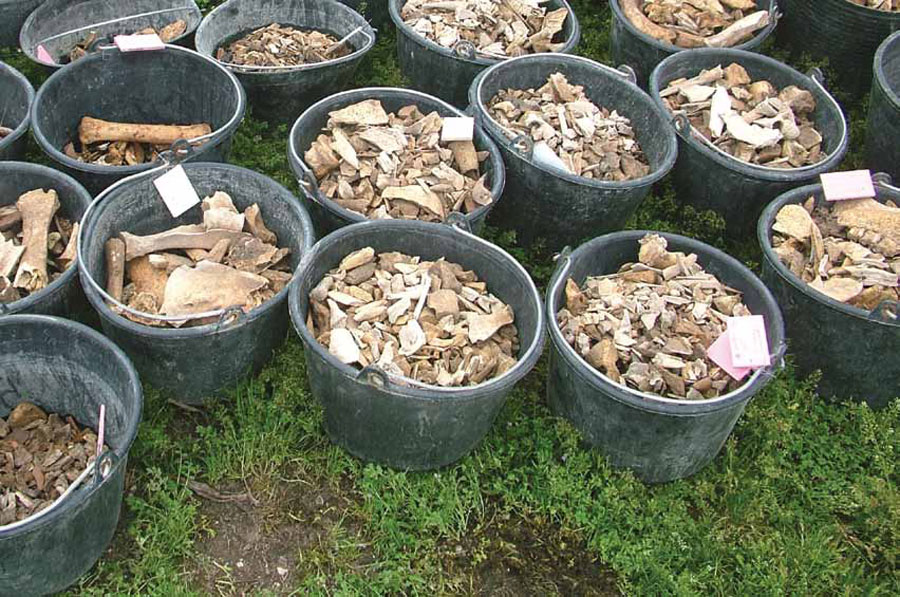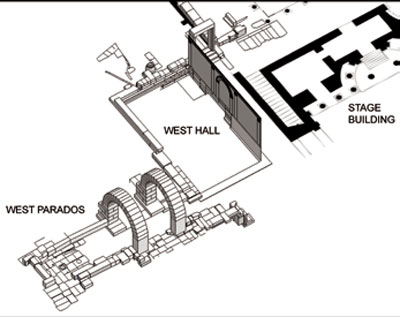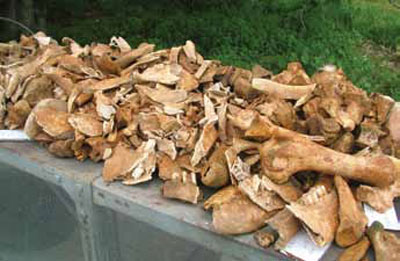
The excavated finds were dry-sieved so that even the smallest bone fragments and teeth could be preserved and identified.
The greek theater of ancient Corinth was reconstructed by the Romans when they re-established the destroyed city as Colonia Laus Julia Corinthiensis in 44 BC. At that time they redesigned the theater to Roman specifications, adding a free-standing single-room hall at either end of the new stage building. It is the hall at the west end of the Roman stage building upon which the American School of Classical Studies at Athens focused this year, largely because, when about two-thirds of the hall was excavated in the 1920s, a good portion of a concentrated dump of cow, sheep, and goat bones was removed without much notice.

We planned to correct that oversight in the spring of 2011 by the careful excavation and analysis of a sample taken from the deposit, about a third of which still remained in situ. Excavation recovered over one ton of discarded bones from the hall and more from the area immediately to its north.
This represents a probable one-eighth to one-tenth of the skeletal waste that had originally covered the area. The excavated fills were dry-sieved to facilitate the collection of all small teeth, bones of birds and rodents, and small slivers of bigger bones, with a preliminary analysis of the material made by Dr. Michael MacKinnon of the University of Winnipeg. Dr. MacKinnon will undertake the final publication of the skeletal material as well.
The prime purpose of the present note is to present a few of the archaeological peculiarities of this very large skeletal deposit. First, the bones were laid down in strata, much of which was sealed at top and bottom by layers of sandy limestone chip waste from the remains of trimmed limestone blocks. The bones had been discarded through an opening in the north wall of the West Hall from a still incompletely explored area to the north. No admixture of pottery or earth was found within the various concentrated pockets of bone. Also, cooking wares and ash were missing from the strata. It appears that the bones came straight from the butcher’s block. Some coins, however, did find their way into the mix.

The refuse is not, however, from a normal urban shop or slaughter house. Pig is totally absent, as are wild and exotic animals. The largest percentage of bone is cattle, ranging from two years in age to animals in their sixth or seventh year. The butchering appears to have been rather casual judging by the knife and cleaver marks.
The most surprising fact about the deposit, however, is its date. Deposition may have occurred from the end of the 4th century or, more likely, starting slightly later and continuing through the mid-5th century AD, possibly into the last decade of the century. This means that the butchered meat was not being produced for use in connection with productions or celebrations in the theater, which at that time was an abandoned ruin. In fact, a comparison of bone waste from carcasses that had supplied meat for attendees of the theater during the 2nd century shows differences in the types of carcasses found and in the parts of the animal that were discarded.

Also, in the building on the east side of the theater where the earlier bones were found, cooking wares were common, and one room was a kitchen. The evidence does point, however, to the bones recovered from the West Hall having accumulated as a result of butchering focused on supplying some sort of celebration or festival. If the meat had been used to celebrate a Christian martyr, the church that was honoring him or her—if it was in the neighborhood— is still to be found. The brief report offered here about the Corinth bone deposit is preliminary. Much research must still be done before final conclusions can be offered. Charles K. Williams II is Director Emeritus of the Corinth Excavations in Greece
